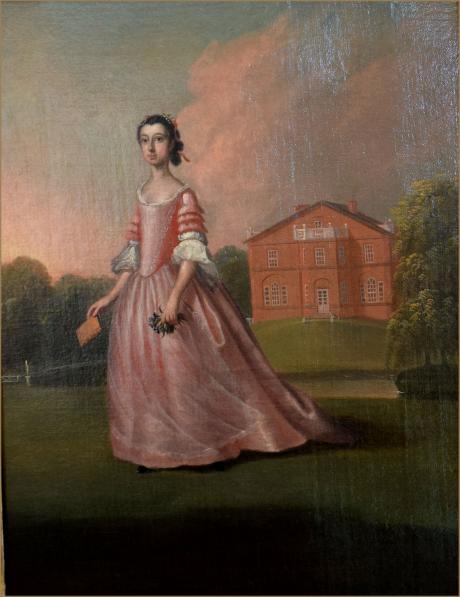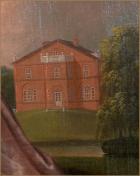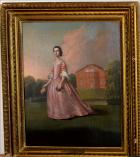"Anne Massingberd / Born 1747; married 1777, the Rev. William Maxwell D. D. / Ormsby Hall in the background"
C Estate of Lili Israel , New York , USA.
Anne Massingberd born on the 26th August 1747 to Ann and William Burrell Massingberd of Ormsby Hall Lincolnshire. She Married the Rev. William Maxwell D. D of Falkland Co Monaghan Ireland in 1777 . They has two children Anne who married the Rev Henry Francis Lyte famous for being the author of the Hymn "Abide with Me". And John William Maxwell who died unmarried.
Sir Drayner Massingberd, brother of Henry of Gunby Hall, bought Ormsby in 1638 having come into a substantial personal fortune via his mother. Over the next twenty years he would purchase 2,600 acres around and about. Drayner’s long tenure at Ormsby set the pattern for the next two centuries: Sir Drayner Massingberd, became Sheriff of Lincoln 1644, and he was knighted by King Charles II. 17 F"eb. 1661.
South Ormsby Hall may be small but it’s a small house by a big name. James Paine, ‘the outstanding country house architect of the mid-C18’, was engaged to produce the brick villa between 1750-56. Ormsby Hall, built by James Paine in 1752, stands in a wooded parkland complete with lake , part of which you can see in this portrait which would have been completed around about the time the house was completed. Though modestly proportioned the house was originally topped off by a distinctly immodest pediment stretching the entirety of the entrance front and ‘nearly twice as long as the house is high’.The pediment lasted only fifty years before being removed by William Carr’s associate Peter Atkinson who was brought in to extend the wings in rear. (A contemporaneous Paine house, Serlby Hall – previously mentioned here – would be similarly shorn of some of the architect’s more fanciful elements after a similar period.) With angled bays on the three original fronts, the restrained refinement continues inside where the centre bay is revealed as three sides of an octagonal entrance room. To the north and south of this space respectively are dining and drawing rooms garlanded with exquisite decorative plasterwork (the hand of Joseph Rose Snr. here), original furnishings and the requisite portraits of successive – mostly father-to-son – squires. As James Lees-Milne noted of the other place, ‘fortune favoured Gunby in all but the male line’ and certainly the Ormsby M-Ms have had generally the better luck in this respect – until now.
The house was enlarged and altered in about 1803 by P. Atkinson, and altered in the 19th and 20th centuries. It was constructed of red brick laid in Flemish bond, with ashlar dressings, and has a hipped slate roof with lead dressings behind a brick parapet. It was altered again in 1927 by Swann and Norman.
There has been a house of some status at South Ormsby Park since the medieval period. The land was owned by the Skipworth family until 1638 when it was purchased by Sir Drayner Massingberd who started to build a house sometime afterwards. It was extended and altered in the early C18 for Burrell Massingberd, and then re-fronted by James Paine in 1750-52. The house was altered and extended by Peter Atkinson & Sons in 1803, and again by Swann & Norman in 1927.
The landscape around South Ormsby Hall was enclosed between 1650 and 1651. A survey of the manor carried out for Burrell Massingberd in 1716 states that there was a ‘House, gardens, orchard, nursery, motes, the garden, the paddock, walnut yards, stewponds, Garth and […] green’. In 1749 William Burrell Massingberd commissioned plans to redesign the parkland from Edward Gardner of Dunston, although it is not clear how much of this design was carried out. A detailed plan of the estate produced in 1803 depicts the landscape park much as it is today. It is thought to have been laid out at some point between 1750, when Paine re-fronted the hall, and 1774 when a survey records the ‘new park’.
Adrian Massingberd-Mundy inherited the estate from father Godfrey when he came of age in 1948 (although not taking the reigns fully until retiring as a Royal Navy submarine officer in 1953). He died last in August 2012 aged 85. Like his only sibling, Anne, Adrian never married hence there appearing to be no obvious heir to the 3,000-acre settled estate. But upheaval remains a stranger to these parts and a successor from the M-M diaspora of his uncle Oswald’s more fecund line will doubtless ensure that the Massingberd arms endure hereabouts not only at the pub down the lane…
Ormsby Hall and its then owner Burrell Massingberd played a significant role in William Kent’s formative years. Most importantly, it states that:
‘Kent’s involvement in country houses began in Rome in October 1715 when he sketched his first recorded architectural design, for a summerhouse for Ormsby Hall, the Lincolnshire seat of his principal patron at that time. In 1717 he began a painting representing “Musick and Poetrey” for the ceiling of a closet at Ormsby Hall. Unfortunately Kent’s work does not survive as Massingberd’s son had the Hall rebuilt, by James Paine’.
South Ormsby, sometimes called South Ormesby, is a village in the East Lindsey district of Lincolnshire, England. It is situated 1 mile (1.6 km) west from the A16 road, 7 miles (11 km) south from Louth and 7 miles north-east from Horncastle. With the nearby hamlet of Ketsby, it forms the civil parish of South Ormesby with Ketsby. The population is included in the civil parish of Brinkhill.
The 15th-century church of St Leonard's is approached by a short climb up a path next to the old school house.
Haytley, Edward (fl. 1740–1764), portrait and landscape painter, is of unknown origins. Given his professional contacts with Arthur Devis and the connections of many of his sitters he may have come from Lancashire. The earliest reference to him is in a letter, dated 21 August 1740, from Elizabeth Robinson to Anne Donnellan, requesting her to send drawings of flowers by both Haytley and her father. She wanted the studies to help her design the embroidery of an apron that she was making for her friend the duchess of Portland (E. Montagu, 1.57). Haytley's skill as a painter of detail is evident in his accomplished conversation piece showing Edward and Elizabeth Montagu with Mrs Montagu's sister, Sarah Robinson. They sit on a terrace at Sandleford Priory, near Newbury, Berkshire, in front of an extensive georgic landscape with haymaking and the village of Newtown in the background (1744; priv. coll., USA). The Montagu papers also contain a description, by Elizabeth Robinson of Mount Norris, near Hythe, Kent, of drawings that Haytley was making of their neighbours the Brockman family, of Beachborough Manor. A description of one drawing corresponds with one of a pair of canvasses, both of which show the newly built Temple Pond at Beachborough (1744; National Gallery of Victoria, Melbourne). The Montagu account books refer to Haytley undertaking a number of other tasks, including repairing pictures.
In 1746 Haytley signed and dated six small-scale full-length portraits of members of the Stanley family (priv. coll.), a triple portrait, possibly representing Matthew and Elizabeth Robinson with their daughter Sarah (priv. coll., USA), and a portrait, known in two versions, of Sir Robert and Lady Bradshaigh posing in front of Haigh Hall (Metropolitan Borough of Wigan and priv. coll.). The settings of the Bradshaigh portraits have the same topographical clarity as the landscapes of Sandleford and Beachborough. Two three-quarters-length portraits, one of Sir Robert Bradshaigh (the other unidentified) are recorded as dated 1750. Two years later Haytley is recorded again painting members of the Montagu family in Kent. In the late 1740s, at the behest of William Hogarth, he donated roundels of Bethlem and Chelsea hospitals to the Foundling Hospital, London; hung in the court room they have become his best-known works.
Haytley contributed two unidentified portraits to the first exhibition at the Incorporated Society of Artists in 1760 and another three to the exhibition of 1761. His last recorded painting, a portrait of Sir William Milner, second baronet, is dated 1764 (Sothebys, 12 March 1980, lot 133). It shares the format of the Stanley portraits, although compositionally it has greater confidence and presence and serves as a pendant to a portrait of Lady Milner by Devis that is dated 1760 (ibid., 132). In the absence of paintings bearing a later date it is presumed that Haytley died soon afterwards. Hugh Belsey DNB
We would like to thank Hugh Belsey for his help in cataloguing this portrait and identifying the artist



